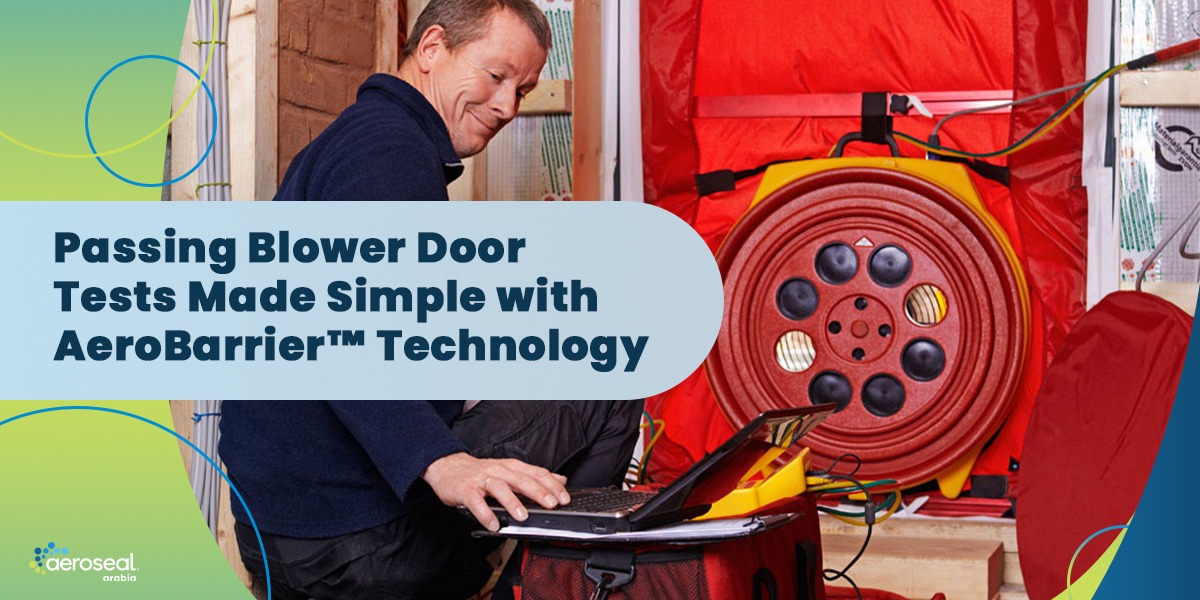
Passing Blower Door Tests Made Simple with AeroBarrier™ Technology
Why Airtightness Matters in Saudi Arabia
In Saudi Arabia’s fast-growing commercial sector, from Riyadh’s high-rise offices to Jeddah’s hospitals and Eastern Province universities, airtight construction is no longer optional it is a requirement. The Saudi Building Code (SBC 602) emphasizes energy efficiency, while Vision 2030 pushes for greener, sustainable buildings that reduce waste and operating costs.
One of the most reliable ways to prove a building’s energy performance is the blower door test, a standard measure of how much air leaks through a building’s envelope. But for many contractors, passing this test is easier said than done. Leaks can be hidden, sealing them manually is labor-intensive, and delays can stall project handovers.
Fortunately, AeroBarrier™ technology offers a proven solution that makes passing blower door tests simpler, faster, and more reliable for commercial buildings across Saudi Arabia.
What Is a Blower Door Test?
A blower door test measures the airtightness of a building. It involves placing a high-powered fan in an exterior doorway, then pressurizing or depressurizing the space. Sensors measure how much air escapes through cracks, joints, and gaps in the envelope.
Results are typically expressed in two ways:
- CFM50 (Cubic Feet per Minute at 50 Pascals) – how much air escapes when the building is pressurized.
- ACH50 (Air Changes per Hour at 50 Pascals) – how many times the air inside the building is replaced in one hour due to leakage.
The lower the score, the more airtight and efficient the building is. For Saudi contractors, achieving these standards is essential for compliance with SBC 602, as well as for lowering future energy costs in commercial operations.
Why Airtightness Is Critical for Saudi Commercial Buildings
Saudi Arabia faces some of the highest cooling demands in the world. With summer temperatures regularly exceeding 45°C, any leakage in a building envelope leads to:
- Massive cooling losses – Air conditioners must work harder, driving up electricity use.
- Inconsistent indoor comfort – Offices, classrooms, and hospital wards may feel unevenly cooled.
- Increased operating costs – Energy bills for large facilities rise significantly due to uncontrolled air exchange.
- Moisture and durability issues – Air leaks can allow humid air to infiltrate, potentially causing condensation and structural damage.
For developers, failing a blower door test means delayed occupancy permits, extended project timelines, and higher costs. That’s why airtightness is not just about comfort it’s about compliance, reputation, and profitability.
Common Challenges Contractors Face
Even the most skilled contractors often struggle to achieve airtightness in commercial projects. Some common obstacles include:
- Hidden leaks around ducts, wiring, and plumbing penetrations.
- Large building footprints with more potential leak points.
- Coordination across multiple trades (electricians, HVAC installers, plumbers) who may compromise sealed areas.
- Inefficient manual sealing methods that miss small gaps or fail under pressure.
- Repeated retests that waste time and money when leaks remain unresolved.
These challenges can delay building handovers by weeks, frustrating clients and straining project budgets.
How AeroBarrier™ Technology Works
AeroBarrier™ offers a game-changing alternative to traditional sealing methods. Instead of manually hunting for leaks, it automates the process and verifies airtightness in real time.
Here’s how it works:
- Preparation – A blower door is installed, and the space is pressurized.
- Application – A non-toxic, water-based sealant mist is released into the building.
- Leak targeting – The mist naturally follows escaping air through cracks and gaps, bonding to the edges to seal them.
- Real-time verification – The blower door continuously measures air leakage, providing instant results.
- Completion – Once the desired airtightness is reached, the system stops automatically, and a digital report verifies compliance.
This process can seal leaks as small as a human hair and up to half an inch in size, ensuring comprehensive coverage without the guesswork.
Benefits of AeroBarrier™ for Saudi Commercial Projects
1. Guaranteed Test Compliance
With AeroBarrier, contractors can pass blower door tests on the first attempt. The technology ensures SBC airtightness requirements are met before the job is handed over.
2. Time and Labor Savings
Instead of weeks of manual sealing and retesting, AeroBarrier completes the job in a single day. Projects stay on schedule, and manpower can be directed to other critical tasks.
3. Energy Efficiency and Cost Reduction
Sealed buildings reduce cooling loads by preventing conditioned air from escaping. For a hospital in Riyadh or a university in Jeddah, this can mean millions saved in long-term operating costs.
4. Healthier Indoor Environments
Airtight buildings keep pollutants, dust, and outdoor humidity from infiltrating, improving indoor air quality in sensitive environments such as healthcare facilities and schools.
5. Alignment with Vision 2030
By improving building performance, AeroBarrier supports Saudi Arabia’s push toward sustainability, energy efficiency, and green certification. Developers who adopt the technology position themselves as leaders in modern construction.
Applications in Saudi Commercial Buildings
AeroBarrier’s versatility makes it ideal for a wide range of projects in the Kingdom:
- Hospitals and Clinics – Ensures critical spaces remain sterile and energy-efficient.
- Universities and Schools – Delivers consistent comfort for students and faculty while cutting cooling costs.
- Office Towers – Enhances workplace comfort and helps companies meet green building standards.
- Shopping Malls and Restaurants – Keeps conditioned spaces comfortable, even with heavy daily traffic.
- Government and Corporate Facilities – Demonstrates commitment to Vision 2030 energy efficiency mandates.
Why AeroBarrier Is the Smarter Choice
Traditional sealing is time-consuming, inconsistent, and prone to failure during testing. AeroBarrier replaces trial and error with a data-driven, automated process that gives contractors confidence and clients peace of mind.
With immediate verification, detailed reports, and guaranteed compliance, it’s not just a way to pass a blower door test it’s a smarter approach to future-proofing Saudi commercial buildings.
Conclusion: Simplify Compliance and Improve Performance
Passing blower door tests is no longer a hurdle for contractors in Saudi Arabia. With AeroBarrier™ technology, projects can achieve airtightness faster, reduce energy waste, and meet strict SBC 602 standards without delays.
Whether you are building a hospital in Riyadh, a university campus in Jeddah, or a corporate headquarters in Dhahran, AeroBarrier ensures your project passes the test the first time saving time, money, and energy for years to come.
It’s time to move beyond manual sealing and adopt a technology that guarantees results. With AeroBarrier, passing blower door tests in Saudi Arabia has never been simpler.



